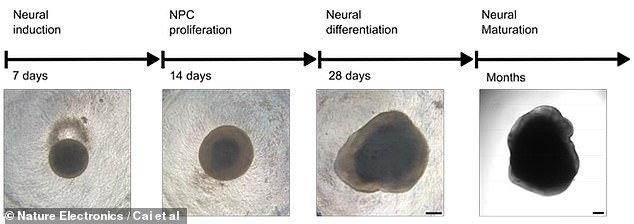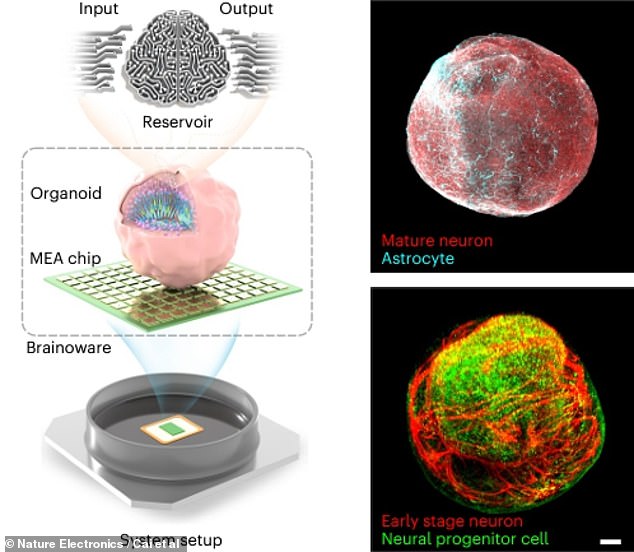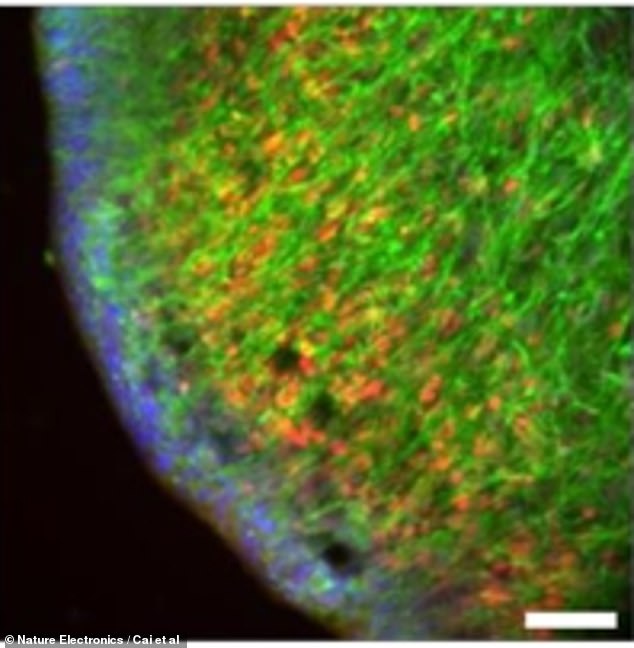Scientists invent ‘Brainoware’ computer that uses human neurons and tech hardware – as they move one step closer to merging man and machine
Scientists have unveiled a hybrid computer made of electronics and tissue similar to the human brain called Brainoware. It's part of a growing field called biological computing.
The new technology features a brain “organoid” made of human stem cells, which sits atop a circuit board that feeds the organoid information and reads its responses.
This bio-electronic hybrid was able to recognize people by voice and predict a complex mathematical problem.
The researchers claim that this discovery represents an important step towards hybrid computers, which combine human and machine to perform complex computing problems using a fraction of the power required by traditional computers.
A human brain organoid sits atop an array of microelectrodes, which feed the small mass of tissue information and record its responses.
It can also support artificial intelligence by enabling computers to mimic the human brain, said the scientists behind Brainoware.
The human mind is a natural computer, evolving over millions of years. Even as electronic computers become more sophisticated and powerful, the brain still outpaces its efficiency when it comes to power requirements, as the team behind Brainoware writes: “The human brain typically consumes about 20 watts, while current AI devices consume about 8 Millions of watts to power it.” Comparative driving (artificial neural network).
In Brainoware's new computer, a brain organoid made of human stem cells sits atop a circuit board that feeds the organoid's information and reads its responses.
Brainoware is an example of what computer scientists call “reservoir computing,” where a computer feeds information into a complex network — in this case, a brain organoid — and interprets the output.
The idea behind tank computing is just that Computers that feed information to brain tissue and read the output can be trained or modified, taking advantage of the organ's complexity without needing to fully map or understand its cell networks.
In other words, the organoid is a kind of “black box,” and scientists don't need to know exactly how it works in order to use it.
The organoid is not part of a living person's brain, but grows from so-called pluripotent stem cells, which are cells that can be stimulated to form any type of body tissue.
Scientists from Indiana University Bloomington, the University of Florida, and Cincinnati Children's Hospital Medical Center have used pluripotent stem cells to grow human cortical organoids.

The brain organoid grows over several months. In the first week, “induction” occurs when scientists stimulate the stem cells to develop into brain cells. During the second week, these neuronal progenitor cells divide and become more numerous. In one month, the organoid contains multiple types of brain cells, and in two months, the organoid matures
After about a month of development, the organoids contained several types of human brain cells, including neurons, neural progenitor cells that grow to form various brain cells, and immune cells called astrocytes.
These organisms mimic very basic aspects of the human cerebral cortex, the surface of the brain that performs basic functions including learning, thinking, and problem solving.
In the speech recognition experiment, Brainoware was asked to recognize the voices of different Japanese men from a set of 240 audio clips.
In the first tests, it achieved only about 51 percent accuracy.
But after two days of training, the device's performance improved to 78% accuracy.

The Brainoware computer setup (left) consists of a cortical organoid located atop a microelectrode array. The organoids used in Brainoware contain multiple types of brain cells, including mature neurons and astrocytes (top right), and early-stage neurons and neuronal progenitor cells (bottom right).
“These findings suggest that electrical stimulation during training may trigger unsupervised learning of Brainoware to improve computing performance by reshaping the functional connectivity of the organelle,” the study authors wrote.
Organic beings cannot “think,” and they do not have consciousness in the way we know it, but they do have the natural ability to form new connections.
A big part of what makes the new computer powerful is the human brain's ability to reorganize.
Under normal circumstances, the human brain will form new connections in response to new experiences – forming memories and learning skills, which are stored in the connections between neurons.
This appears to be what is happening with Brainoware.
In another test of its problem-solving abilities, the scientists tasked Brainoware with predicting a Hénon map, a messy type of nonlinear mathematical equation.
Just as in the speech recognition exercise, the system improved its accuracy after several training regimes.

After three months of development, the brain organoids contained neural progenitor cells that can grow into neurons, as well as mature neurons.
When scientists blocked neural plasticity — the ability of organisms to form new connections — no such improvement occurred.
“The results indicated that Brainoware's learning activity was dependent on neural plasticity,” they wrote.
The work appeared today in the magazine Nature electronics.
Brainoware's development supports the idea that hybrid brain-computer systems can solve complex problems, but more work is needed to truly prove their capabilities, another team of researchers wrote in a study Comment invited.
“In the next steps to show that brain organoids can serve as a model for learning in the laboratory, it will be necessary to demonstrate aspects of long-term memory, the ability to learn multiple tasks and to differentiate the unique contribution of organoids across connected computational systems,” they wrote.
“This will be crucial for studying the biological mechanisms that enable lifelong learning.”
(Tags for translation)dailymail
